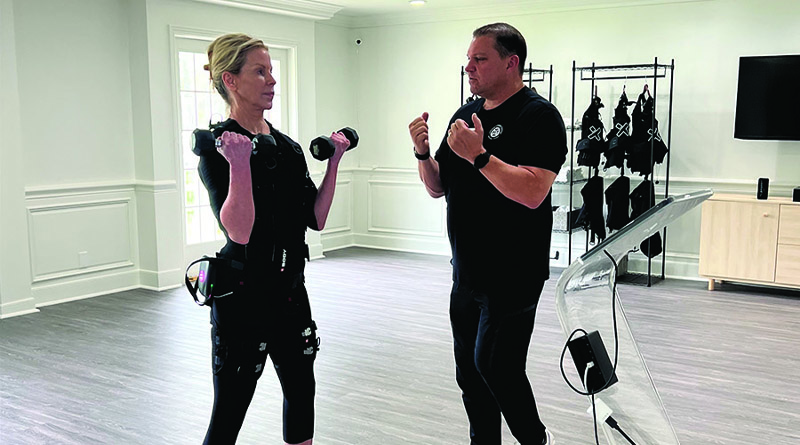
When Heather Dubrow, wife of plastic surgeon and television personality, Terry Dubrow, tried Electrical Muscle Stimulation (EMS) during an episode of The Real Housewives of Orange County, I thought it was likely just another “best kept secret” gimmick.
I enjoy staying active, but am not an exercise junkie, and the thought of accelerating the benefits of a workout piqued my interest. So, when the fitness professionals at Cooper Fitness Center invited me to take part in an EMS demonstration session, I thought, why not?
I met with Mary Edwards, Cooper Clinic’s director of fitness, and Dave McGarry, EMS lead fitness trainer. McGarry explained the benefits of EMS, including increasing strength and endurance, increasing energy expenditure during and after a workout due to full engagement of major muscle groups, and accelerating metabolism by adding lean mass and improving body composition.
According to McGarry, EMS uses electrical impulses to stimulate the contraction of the muscles. In the time-efficient 20-minute workout, electrodes are strategically placed within a training suit over all major muscle groups, and the external stimulation, coupled with simple voluntary movement, causes intensified muscle contractions.
“EMS can help engage muscles beyond human capacity and motivation because it stimulates both fast-and slow-twitch muscles simultaneously,” explained Edwards — the added description of the low-impact workout being “joint-friendly” was music to my ears, and my achy joints.
After squeezing into a dampened garment resembling a wetsuit (McGarry explained that the water in the EMS training suit acts as a conductor, helping electrical impulses reach muscles more effectively), the straps of my suit were tightened — the preparation reminiscent of being secured in a life vest before water skiing.
McGarry explained how the workouts can be customized for each client and can include concentration on a specific area of the body, offering an increased focus on muscle development or on endurance as options for my workout.
After pairing the EMS suit with the app and entering a few personal questions, including date of birth, height, weight, and current activity level, McGarry adjusted various degrees of impulse intensities to my quads, hamstrings, glutes, abs, back, chest, and arms. The virtual trainer provided prompts for inhaling and exhaling, functional core movements, and common strength exercises including biceps curls, standing crunches, and squats.
My anticipation of the technology doing most of the workout for me while I barely broke a sweat or intensified my breathing was fleeting as McGarry encouraged me to complete my fourth arm set of “water splashing.”
“You’re getting an efficient, low-impact, joint-friendly workout while getting more out of your workout in less time,” explained McGarry, who also cautioned that EMS is no magic bullet and should not be substituted for regular exercise and a healthy diet.
In other words, there’s no putting on the suit, turning on the electric impulses, taking a nap, and waking up looking like Jillian Michaels.
McGarry prepared me for some post-workout soreness, which intensified on day two, but resembled the amount of soreness I’d have after a good leg day.
I’d recommend EMS to anyone wanting to add to the benefits of a workout in a shorter amount of time, is up to incorporating innovative technology into their fitness routine, or to anyone who just needs some extra motivation — or electrical stimulation — to up their exercise routine.
